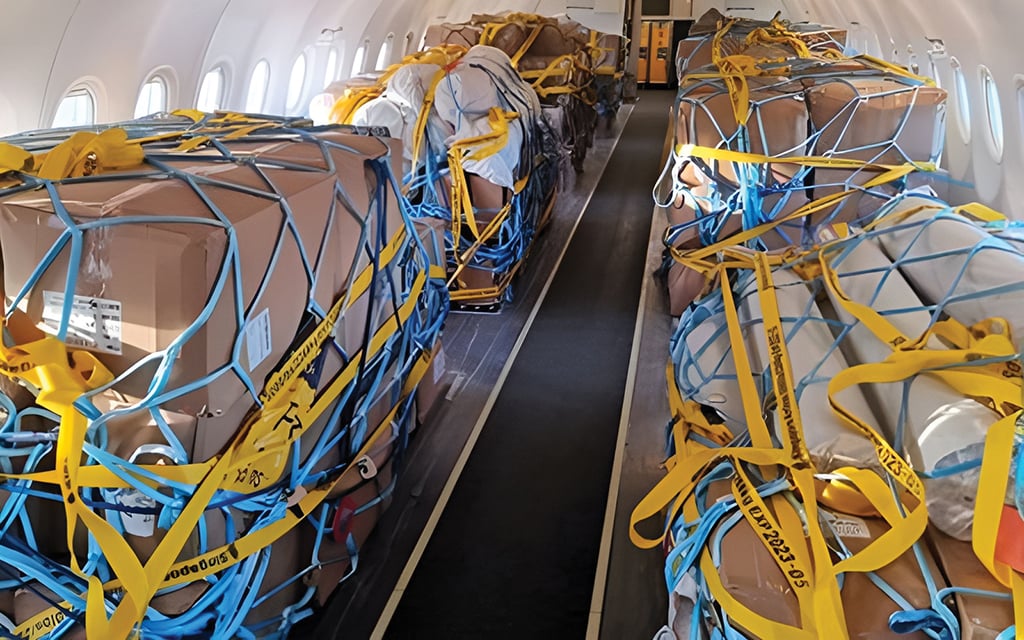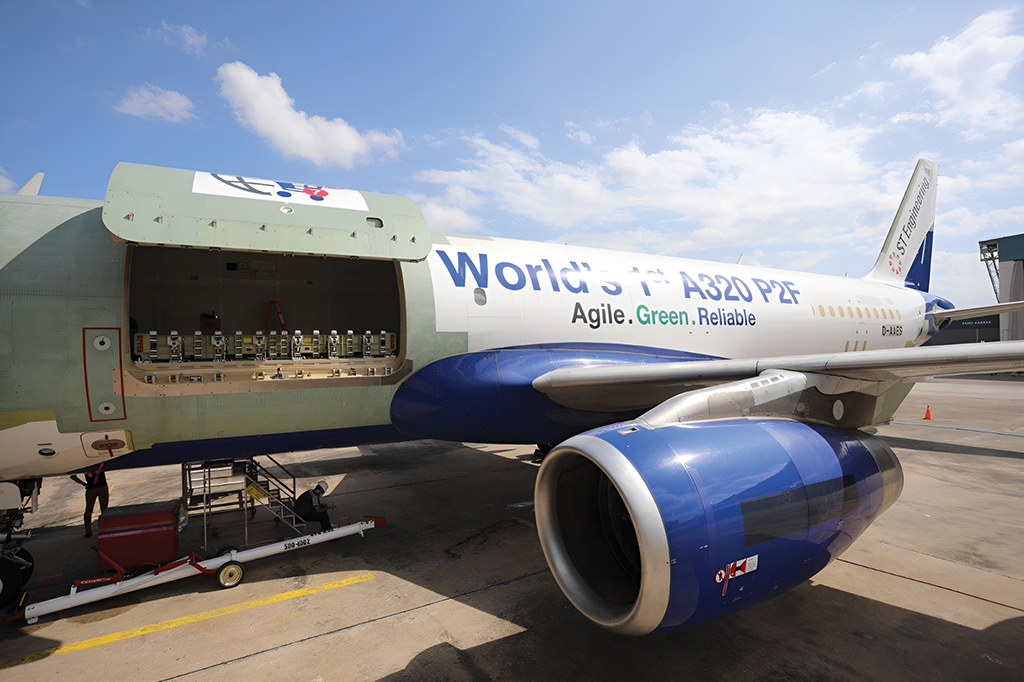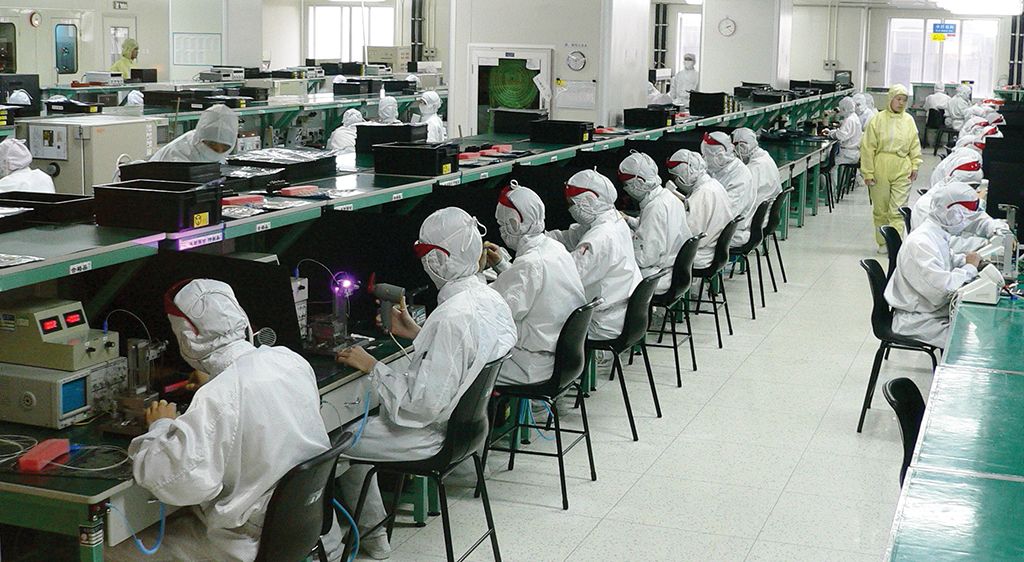
The interior of a Singapore Airlines Boeing 777-300ER converted to a freighter during the pandemic.
Often referred to as the “factory of the world,” the Asia-Pacific region generates approximately one-third of global airfreight each year. Typical exports from the region are lightweight, high-value, time-sensitive or a combination of all three, such as electronics, pharmaceuticals, fresh produce, seafood and luxury goods. Meanwhile, the region’s rapid economic growth and urbanization have led to a surging demand for similar imports from the rest of the world, as well as within the region.
Where demand for airfreight leads, demand for cargo capacity follows, be it for aircraft belly space, production freighters or passenger-to-freighter (P2F) conversions.
Boeing estimates the global P2F market will reach $5.19 billion by 2029, and forecasts approximately 1,300 P2F deliveries globally over the next two decades—66% of the total demand for freighter conversions. The manufacturer estimates the Asia-Pacific will receive nearly 500 of them, the largest share among all regions. That would make the region’s freighter fleet comparable in size to that of North America, indicating a growth rate of more than three times its pre-pandemic fleet.
Airbus forecasts similar figures, predicting the need for 1,590 more conversions from 2023-42, with 600 going to the Asia-Pacific. Both manufacturers have announced plans to increase conversions of their own aircraft to cater to this demand.
Embraer, too, has entered the fray by introducing its E-Jet conversion initiative in March 2022, with the first to be operational in 2024. The aim is to address the demand for freighter capacity between turboprops and narrowbodies, which it believes will be a popular choice in many parts of Asia-Pacific. Embraer’s E-Jet conversion program anticipates a need for 700 E-Jet freighters over the next 20 years, with China accounting for 34% of worldwide demand. Presently, 85 E-Jets are operational in China, serving airlines such as Guangxi Beibu Gulf Airlines, Colorful Guizhou Airlines, Hebei Airlines and Tianjin Airlines, so they are already a popular model type.

However, while these forecasts are optimistic, Asia-Pacific’s P2F ecosystem is complex and fragmented. Conversion capabilities are constrained, national regulations lack alignment, sustainability rules are evolving and air cargo volatility brings risks. Segment dynamics are also shifting as economies reopen post-pandemic.
Realizing the region’s immense potential will require deft navigation of these challenges, including disciplined capacity growth, sustainable profitability, regulatory coordination and balanced investment strategies. If stakeholders collaborate, the Asia-Pacific regions’s stature as a preeminent global P2F hub can keep rising.
Drivers of Surging Demand
But why has the region emerged as a hotbed for aircraft conversions?
The pandemic caused an exponential rise in e-commerce and online shopping, with Asia-Pacific at the epicenter supplying global demand. Market research firm eMarketer says the region’s retail e-commerce sales expanded by a massive 74% in the past two years, far more than in any other region.
This surge fueled air cargo volumes as consumers clamored for faster deliveries, leading to logistics companies tapping air transportation. With the fall in belly capacity (see below), dedicated freighter capacity became essential and P2F models allowed carriers to rapidly add that capacity to their networks.
The decrease in passenger flights due to health and safety restrictions related to the pandemic reduced available belly space for cargo on passenger aircraft. Operators including Singapore Airlines and Cathay Pacific completely reversed the pre-pandemic trend of airlines reducing or even entirely eliminating their freighter fleets, and pivoted capacity by converting idled passenger aircraft into freighters.
While some carriers, such as Air Astana, have swiftly dropped their P2Fs and moved back to the comforting familiarity of all--passenger fleets, others have continued investing in converted freighters even after lockdowns eased, having rediscovered the value of having a versatile fleet mix. IndiGo, India’s largest airline, welcomed its first converted freighter, an Airbus A321P2F, in late 2022 and plans continued cargo expansion, both domestically and internationally.
Finally, Asia’s manufacturing landscape is progressively shifting production from China to lower-cost countries such as Vietnam, Malaysia and Indonesia. The International Air Transport Association expects this trend could triple Southeast Asia’s cargo volumes by 2035 with these production shifts. As manufacturing sees this redistribution, companies reshape their supply chains.
In total, these factors have driven a major increase in demand for P2F conversions. How much they will continue to do so, as passenger travel’s recovery post-pandemic brings with it increased belly capacity and fewer grounded aircraft to convert, remains to be seen.
Challenges and Complexities
The region also faces an array of complex challenges—constrained supply, regulations, sustainability, volatility risks and overcapacity concerns—that require nimble navigation.

Rising P2F demand is already outstripping Asia’s conversion capabilities, causing project delays and backlogs. For example, Singapore’s ST Engineering says its conversion slots for Airbus A320/321P2Fs and A330P2Fs are fully booked through 2026. It has announced heavy investment into additional P2F capabilities across China, Singapore and the U.S. to ease the capacity crunch, as are other conversion players operating in the region, including Israel Aerospace Industries and Elbe Flugzeugwerke. New capacity is slow to come online, however, as major new conversion centers take years to complete. The availability of qualified MRO partners to perform conversions is also limited, causing a bottleneck that hampers the pace of expansion.
The Asia-Pacific region’s fragmented regulations create another barrier. Each country has distinct processes and directives for certifying aircraft modifications, and these requirements lack harmonization between jurisdictions. Industry group Aircraft Fleet Recycling Association (AFRA) has long campaigned for greater coordination between regulators to align standards and expedite certification to ease the regulatory backlogs delaying P2F projects throughout the region. Earlier this year, Jason Dickstein, president of Washington Aviation Group, which represents AFRA, told Aviation Week about a collaboration between AFRA and the Civil Aviation Administration of China to help global companies navigate China’s regulations combatting counterfeit parts. While encouraging, it is only a fraction of the work that needs to be completed to serve current market demands.
Although “greener” than manufacturing new aircraft, conversions face significant and overlapping environmental regulations due to greater governmental and industry standards regarding emissions. For example, the International Civil Aviation Organization’s latest CO2 standards (Volume 3 to Annex 16 of the Chicago Convention) took effect this year and present hurdles for certain aging Boeing freighters, such as 777Fs and 767-300Fs. While the standards do not directly impact passenger-to-freighter conversion programs, converted aircraft will still face the same operating constraints as other older freighters when the 2028 in-service compliance deadline approaches. Any models not meeting the CO2 targets by then will face potential usage limits.

P2F converters will need to consider sustainability as a factor when selecting aircraft for conversion in the future. Retiring passenger aircraft with newer engine options that can more easily be adapted to meet emissions regulations is likely to become preferable. Striking the optimal balance between profitability and compliance will be an ongoing challenge.
Changeable market conditions introduce uncertainty as well. For instance, airfreight rates softened in late 2022 after spiking during the pandemic. While they have since stabilized, they teeter on a knife-edge. Talking of the fall in rates, the freight forwarder group Globalia Logistics Network says it does not expect the rates to return to their previous high anytime soon. “It needs to be remembered that the sector is in damage-control mode after the pandemic and a further rise in rates will impact the profitability of this sector,” says a company representative. Globalia cited the more conservative spending habits of consumers due to widespread global inflation for the drop. Should inflation increase, dampening consumer confidence, airfreight demand will inevitably decline, affecting demand for conversions.

Fluctuating oil prices also directly impact operating costs, something that has been especially apparent following Russia’s invasion of Ukraine. Changing trade policies and currency swings also influence cargo flows and airline routes.
Even though the increase in capacity demand has been recent, overcapacity concerns already loom for some models. More than 200 Boeing 737-800s have been converted to freighters, and 737 fleets may soon surpass converted 757 freighters that took far longer to scale. Consultancy IBA warns this rapid growth signals future oversupply risks, and its data shows 737 values declining recently as the supply increased.
Enablers of Collaboration
Asia-Pacific’s P2F growth relies on OEMs, MROs, lessors and airlines working collaboratively. Each plays an integral role in this ongoing trend. OEMs, such as Boeing, Airbus and Embraer, provide trusted conversion solutions tailored for the region’s carriers. Boeing’s 737-800BCF and Airbus’ A320/A321P2F models are popular in Asia, and their certification inspires confidence. MROs execute conversion projects by leveraging technical expertise—their experience smooths program implementation across Asia’s fragmented landscape. Aircraft lessors also aggregate demand by placing large conversion orders they then lease out as carriers need them. BBAM, Aircastle, Avalon and others have fueled growth by embracing fleet flexibility.

This assembly of stakeholders must align strategies and expertise to address the many challenges looming. Airlines assess market needs, lessors provide capital, OEMs design solutions and MROs deliver them. Partnership between these players enables navigating risks, constraints and complexities more adeptly. Their collaboration is critical to unlock Asia-Pacific’s immense potential as a global P2F hub.
Future Outlook
The future of the Asia-Pacific passenger-to-freighter sector looks very positive, but it’s important to approach with cautious optimism due to changing market dynamics. Industry experts predict that air cargo will continue to grow by about 4% each year for the next 10 years. While this growth rate might be lower than the peak during the pandemic, it is still significant. Ongoing trends in manufacturing and e-commerce remain favorable for airfreight. Surveys also indicate that 91% of shippers plan to use air cargo at least as much as they do now or more over the next five years. This suggests strong demand that can withstand short-term fluctuations.
However, the ability to manage change effectively will determine success in this industry. Leading airlines in Asia have shown their adeptness at switching between passenger and cargo operations using converted aircraft. Their flexibility demonstrates how important it is to be adaptable. While optimism is high now, growth strategies need to be carefully balanced. Long-term plans should consider potential risks, and adjusting capacity according to changing demand is crucial. If aircraft converters, leasing companies and airlines collaborate effectively, the Asia-Pacific P2F sector can flourish despite its complexity.